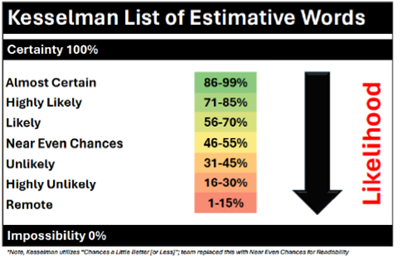[Editor’s Note: One enduring aspect of the Operational Environment familiar to Mad Scientist Laboratory readers is — that which can be detected, can be targeted. This constant dynamic of Finders vs Hiders has recently favored the Finders, as most competitors can now access space-based surveillance, networked multi-static radars, a plethora of UAVs, and a vast array of passive and active sensors that are far cheaper to produce than the countermeasures required to defeat them. Quantum computing and advanced sensing will open new levels of situational awareness. Passive sensing, especially when combined with artificial intelligence and big-data techniques, may routinely outperform active sensors. Hiding will still be possible, but will require a dramatic reduction of thermal, electromagnetic, and optical signatures.
Today’s post, by the U.S. Army War College’s Team Sullivan’s Travels member LtCol Erik Keim (USMC, Communications), addresses a promising method for “hiding” amongst an obscuration of emitters and signals — presenting adversaries with a veritable needle within a stack of like-appearing and emitting needles. The Ukrainian Armed Forces’ fight against their Russian invaders has proven that electronic decoys and “using the same frequencies as commercial products like Bluetooth, Wi-Fi, 4G, and 5G networks allows forces to digitally camouflage their transmissions,” effectively enabling troops to “hide in plain sight” — Enjoy!]
Executive Summary
It is highly likely (71-85% — Note: The Kesselman List of Estimative Words legend may be found at the conclusion of this blog post, above the disclaimer statement) that militaries will blend with civilian transmissions instead of relying solely on the specific military electromagnetic spectrum by 2030 due to the availability of Software Defined Radios (SDRs) and the proven success of digital camouflage. Despite the military’s strong cultural bias to only use reserved military spectrum, the risk of easy detection will necessitate the use of civilian frequencies.
Discussion

Software-defined radios (SDRs) break free from traditional radios’ hardware limitations by using software to adjust their operating frequency bands. This allows SDRs to function across a much wider spectrum range compared to their hardware-restricted predecessors. By leveraging SDRs for radio direction finding techniques, the Ukrainian military tracks Russian communications, enabling them to pinpoint the location of both command-and-control nodes and even individual Unmanned Aerial Vehicle (UAV) operators. Commercially available SDRs revolutionize Ukrainian communications intelligence by enabling a single device and antenna to scan the entire electromagnetic spectrum, detecting Russian communications across all potential frequencies, unlike traditional radios which required dedicated equipment for each band. Upon pinpointing Russian forces with SDR technology, Ukrainians unleash devastating attacks, employing a lethal arsenal ranging from traditional mortars and artillery to cutting-edge rocket-propelled systems and even First-Person View (FPV) UAVs.
Ukrainian forces are using a combination of electronic decoys as well as techniques to blend in with commercial communication networks to reduce the risk of detection by Russian Forces.  Traditional military radios broadcast on reserved frequencies with much higher power than commercial transmissions, making it easier for the adversary to distinguish between military and civilian transmitters. Using the same frequencies as commercial products like Bluetooth, Wi-Fi, 4G, and 5G networks allows forces to digitally camouflage their transmissions. While standard camouflage prevents the enemy from quickly seeing your location by blending in with the environment, digital camouflage in the electromagnetic spectrum achieves the same end-state by blending in with civilian transmissions in that area.
Traditional military radios broadcast on reserved frequencies with much higher power than commercial transmissions, making it easier for the adversary to distinguish between military and civilian transmitters. Using the same frequencies as commercial products like Bluetooth, Wi-Fi, 4G, and 5G networks allows forces to digitally camouflage their transmissions. While standard camouflage prevents the enemy from quickly seeing your location by blending in with the environment, digital camouflage in the electromagnetic spectrum achieves the same end-state by blending in with civilian transmissions in that area.
Lacking modern radio equipment with transmission encryption, Russian forces in occupied areas of Ukraine find themselves susceptible to radio jamming and eavesdropping. Ukrainian jamming tactics have rendered traditional Russian single channel radios ineffective, forcing Russian forces to resort to unreliable communication methods like commercial radios and even cellular phones. By using these less secure systems, the Russians make it easier for Ukrainians to listen in on their unsecured communications.
Analytical Confidence
The analytic confidence for this estimate is moderate. Sources were generally reliable and tended to corroborate one another. There was adequate time, but the analyst worked alone and did not use a structured method. Furthermore, given the lengthy time frame of the estimate, this report is sensitive to change due to new information.
If you enjoyed today’s post, check out Team Sullivan’s Travels‘ Future Dynamics of Warfare: Everyone is a Player, Everything is a Target, along with their associated Final Report from which today’s post was excerpted.
Review our series of blog posts exploring what we’re learning about the Operational Environment:
Unmanned Capabilities in Today’s Battlespace
The Operational Environment’s Increased Lethality
WMD Threat: Now and in the Future
The Hard Part of Fighting a War: Contested Logistics
Revolutionizing 21st Century Warfighting: UAVs and C-UAS
Explore the TRADOC G-2‘s Operational Environment Enterprise web page, brimming with information on the Operational Environment (OE) and how our adversaries fight, including:
Our China Landing Zone, full of information regarding our pacing challenge, including ATP 7-100.3, Chinese Tactics, BiteSize China weekly topics, People’s Liberation Army Ground Forces Quick Reference Guide, and our thirty-plus snapshots captured to date addressing what China is learning about the Operational Environment from Russia’s war against Ukraine (note that a DoD Common Access Card [CAC] is required to access this last link).
Our Russia Landing Zone, including the BiteSize Russia weekly topics. If you have a CAC, you’ll be especially interested in reviewing our weekly RUS-UKR Conflict Running Estimates and associated Narratives, capturing what we learned about the contemporary Russian way of war in Ukraine over the past two years and the ramifications for U.S. Army modernization across DOTMLPF-P.
Our Running Estimates SharePoint site (also requires a CAC to access), containing our monthly OE Running Estimates, associated Narratives, and the 2QFY24 OE Assessment TRADOC Information Paper (TIP).
Read the following related posts:
Pattern Detected! Masking by Injecting Randomness, by Chris Butler
Nowhere to Hide: Information Exploitation and Sanitization
War Laid Bare and Decision in the 21st Century, by Matthew Ader
Battlefield sensing and AI discussions in The Future of Ground Warfare and associated podcast, with proclaimed Mad Scientist COL Scott Shaw
Battlefield transparency and masking discussions in Top Attack: Lessons Learned from the Second Nagorno-Karabakh War and its associated podcast, as well as Sooner Than We Think: Command Post Survivability and Future Threats and its associated podcast, both with COL John Antal (USA-Ret.)

Disclaimer: The views expressed in this blog post do not necessarily reflect those of the U.S. Department of Defense, Department of the Army, Army Futures Command (AFC), or Training and Doctrine Command (TRADOC).



